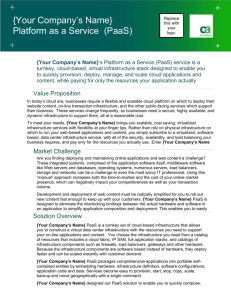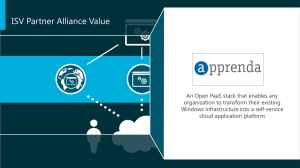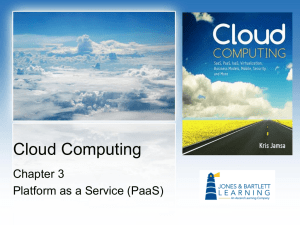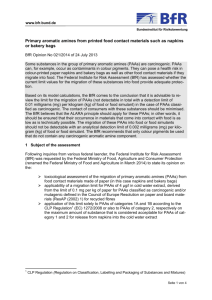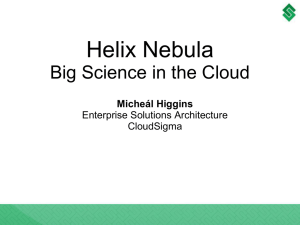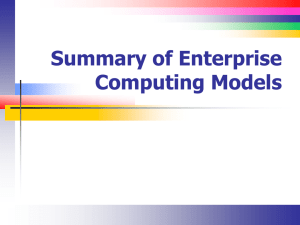Platform-as-a-Service as an Enabler for Global Software
advertisement
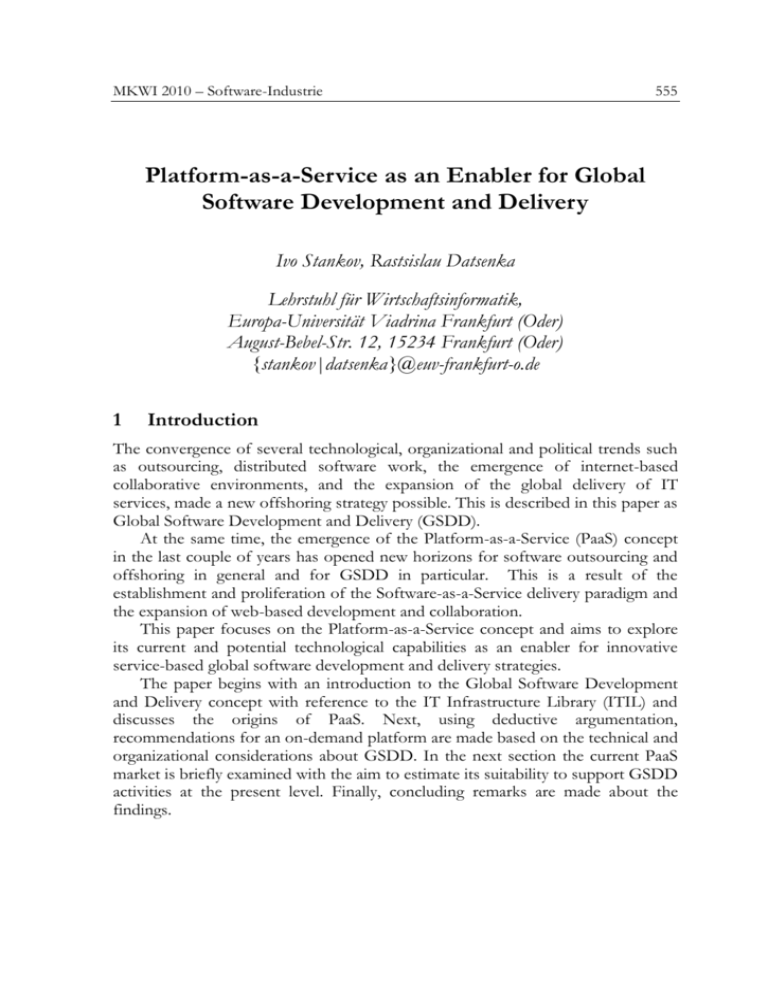
MKWI 2010 – Software-Industrie
555
Platform-as-a-Service as an Enabler for Global
Software Development and Delivery
Ivo Stankov, Rastsislau Datsenka
Lehrstuhl für Wirtschaftsinformatik,
Europa-Universität Viadrina Frankfurt (Oder)
August-Bebel-Str. 12, 15234 Frankfurt (Oder)
{stankov|datsenka}@euv-frankfurt-o.de
1
Introduction
The convergence of several technological, organizational and political trends such
as outsourcing, distributed software work, the emergence of internet-based
collaborative environments, and the expansion of the global delivery of IT
services, made a new offshoring strategy possible. This is described in this paper as
Global Software Development and Delivery (GSDD).
At the same time, the emergence of the Platform-as-a-Service (PaaS) concept
in the last couple of years has opened new horizons for software outsourcing and
offshoring in general and for GSDD in particular. This is a result of the
establishment and proliferation of the Software-as-a-Service delivery paradigm and
the expansion of web-based development and collaboration.
This paper focuses on the Platform-as-a-Service concept and aims to explore
its current and potential technological capabilities as an enabler for innovative
service-based global software development and delivery strategies.
The paper begins with an introduction to the Global Software Development
and Delivery concept with reference to the IT Infrastructure Library (ITIL) and
discusses the origins of PaaS. Next, using deductive argumentation,
recommendations for an on-demand platform are made based on the technical and
organizational considerations about GSDD. In the next section the current PaaS
market is briefly examined with the aim to estimate its suitability to support GSDD
activities at the present level. Finally, concluding remarks are made about the
findings.
556
2
Ivo Stankov, Rastsislau Datsenka
Global Software Development and Delivery
The term Global Software Development and Delivery describes the workflow and
governance of distributed IT offshoring projects. GSDD exploits time,
geographical location (onsite, near- and offshore), and collaborative techniques
with the aim to reduce costs and to optimize the quality of software products
(Kurbel and Datsenka 2009).
The three major elements of GSDD as described by IBM (Parvathanathan et
al. 2007, p. 5) are geographically shared software development, global delivery, and
seamless collaboration between production teams. This paper focuses mainly on its
delivery component and references the ITIL V2 as a sample model of
investigation. The choice in favor of the older ITIL V2 is motivated by the fact
that it specifically identifies and describes service delivery as a distinctive entity
within the software lifecycle, whereas ITIL V3 introduces a different framework
which does not explicitly refer to the delivery component (Bon 2008, p. 4).
In terms of ITIL, development is an integral part of application management
and includes requirements analysis, design, implementation, operation, and
optimization, whereas delivery describes capacity, availability, continuity, and
financial management (Cusick and Prasad 2006, p. 33). Additional to development
and delivery, a collaborative environment is an extra component of GSDD that is
also a part of the IT Infrastructure Library and works as a bridge that binds
globally distributed teams. Cusick and Prasad (2006, p. 97) describe such an
environment as follows: “A collection of hardware, software, network
communications and procedures that work together to provide a discrete type of
computer service. There may be one or more environments on a physical platform,
e.g. test, production. An environment has unique features and characteristics that
dictate how they are administered in similar, yet diverse manners”.
Figure 1 illustrates a sample methodology of global software development and
delivery from the ITIL perspective adjusted to the needs of globally distributed
software project.
The emergence and expansion of GSDD can be attributed to the rapid growth
of offshoring activities by the top Indian software providers. At the turn of the
century, Indian companies such as Wipro, Infosys and TCS had brought to the
market a number of so-called Global Delivery Models (OECD 2006, p. 128).
The Global Delivery Model (GDM) is an implementation of GSDD which
brings software delivery to both onsite and globally distributed offshore locations
(Buxmann et al. 2008, p. 172). The rapid emergence of this new generation of
offshoring models was highlighted by Kurbel (2008, p. 224) and can be explained
by the general move of the IT industry from classical offshoring to agile and
distributed techniques of software development and by the advances in networking
technology. The popularity of the model is stressed by the fact that already in 2006
51% of all offshoring contracts involved global software delivery (TPI 2006, p. 20).
MKWI 2010 – Software-Industrie
557
Global Software Development and Delivery
Collaborative environment
Software development
Service delivery
Requirements
Design
Implementation
Operation
Optimization
Capacity management
Availability management
Continuity management
Financial management
Figure 1: GSDD methodology based on IT infrastructure library
Major benefits of GSDD include reduction of cost (development in low-cost
locations in India, China or Eastern Europe), diminishing risks of project failures
(distributed development), agile approach to customization, and access to the
global pool of talented developers.
Despite these benefits, GSDD is exposed to a number of risks including,
among others, complexity of project management in the geographically distributed
teams, communication issues, technical challenges, and capacity problems (Hussey
and Hall 2007, pp. 79-80). In order to reduce these risks major offshoring
providers employ a number of standardized process optimization techniques and
reference models including RUP, CMMI, ISO 9001.
This paper proposes and examines a different approach that can support
further improvement of GSDD. This new approach is based on web-based
development and PaaS technologies which, when mature, may change the
offshoring landscape significantly.
3
Platform-as-a-Service within the cloud computing paradigm
3.1 Cloud Computing
In their effort to summarize a first comprehensive definition of clouds in the sense
of cloud computing, Vaquero et al. (2009, p. 50) point out the following main
characteristics of the new phenomenon: scalability, pay-per-use utility model and
virtualization.
558
Ivo Stankov, Rastsislau Datsenka
In this sense, according to Armbrust et al. (2009, p. 1), from an infrastructure
perspective, the cloud computing paradigm provides three distinctive new aspects
that set it apart from previous developments in the client/server sphere: (1) the
"illusion" of a seemingly indefinitely big resource pool which eliminates the need
to plan ahead for possible increases in demand. (2) The lack of need for an upfront commitment to a particular level of service, allowing companies to pay as
much for resources as they actually use, which leads to the third point - (3) the
granulation of the services - the user pays for the actual amount of resources used.
Figure 2: Layers of a typical cloud computing architecture (Joseph 2009)
The term cloud computing is used to describe not only a type of virtual, elastic
infrastructure, but also a range of services that are based on an Internet ondemand, pay-as-you-go paradigm. Figure 2 depicts a general view of a typical cloud
computing architecture. This paper focuses mainly on the middle layer between the
infrastructure (IaaS) and the applications – the platform.
3.2 Platform-as-a-Service
Platform-as-a-Service is positioned between SaaS and IaaS and generally refers to
internet-based software delivery platforms on and for which third-party
independent software vendors or custom application developers can create multitenant, web-based applications that are hosted on the provider's infrastructure and
are offered as a service to customers.
The main premise of PaaS is providing software developers and vendors with
an integrated environment for development, hosting, delivery, collaboration, and
support for their on-demand software applications. Like other software platforms
MKWI 2010 – Software-Industrie
559
(Gawer and Cusumano 2008, p. 28), PaaS aims to be a foundation for a broad,
interdependent ecosystem of users and businesses. It can support tasks from code
editing to deployment, runtime, and management (Lawton 2008, p. 13). The
current PaaS ecosystem shows a wide range of different levels of service and is
described briefly in section 5. Some platforms offer little more than a set of APIs
on top of an elastic infrastructure, while others offer fully functional web-based
IDEs and/or 4th generation programming language environments allowing an easy
creation of metadata-level (Coffee 2009, p. 26) mash-ups. Additionally, a PaaS
could support built-in back-end functionalities of applications like billing,
metering, advertising, etc. (Dubey and Wagle 2007, p. 10), which are generally
inherent in the “as-a-service” model. Revenue is generated, similar to other
software platforms (Evans et al. 2008, p. 3), mainly from the end users. To
summarize, a web-based service platform offers a wider range of functions and
services than the standard stationary platforms.
Considering this, it can be argued that the PaaS model might be disruptive to
the business and strategic practices of ISVs and developers that decide to embrace
it and develop their applications for it. The following section discusses the
potential implications of PaaS on the evolution of software development and
delivery, based on relevant components of the ITIL framework. Considering the
global nature of the network-based PaaS and SaaS paradigms, this paper
specifically looks into the concepts of distributed work and collaboration within a
global software development and delivery framework.
4
PaaS as an enabler of GSDD
4.1 Methodology
This section outlines the compatibility between GSDD and PaaS based on the
ITIL V2 framework and materials gathered from the investigation of several case
studies describing organization of workflow in a typical distributed offshoring
project.
For the ITIL perspective we mainly refer to the ITIL’s Service Delivery Book
(OGC 2004) and to the ITIL® V2 Glossary v01 (OGC 2006). As a reference for
GSDD concept we denote a number of practical examples from Parvathanathan et
al. (2007), Cusick and Prasad (2006), and Lawton (2008).
The aim is to integrate GSDD with the PaaS technology described in the
previous section in order to outline an on-demand platform that may suit the
needs of offshoring development and delivery.
560
Ivo Stankov, Rastsislau Datsenka
4.2 Software development
According to ITIL (OGC 2004, p. 128), software development involves designing,
developing, testing, supporting, and implementing applications. In an offshoring
project these functions are normally spread between globally distributed teams and
are executed simultaneously from multiple locations. As Cusick and Prasad (2006,
p. 27) mention in their GSDD case study, in order to provide a sustained quality of
final code, vendors have to heavily rely on the industry specific standards:“Projects
that have only partial environments replicated offshore have had significant
integration problems once the code was brought back onsite. Teams must evaluate
their environments for portability and might need to execute tactical projects to
convert code bases before offshoring”.
This passage highlights that a PaaS suitable for an offshoring project should
possibly rely on standard development tools and languages in order to reduce
training time and to provide integration of development environments between
distributed teams, thus reducing costs of development (Lawton 2008, p. 15). PaaS
also makes possible the integration of development tools in form of IDE-as-aService (Gotel et al. 2009, p. 89).
4.3 Service delivery
According to the ITIL glossary (OGC 2006, p. 33), service delivery involves the
core IT service management processes that have tactical or strategic focus, namely,
service level management, capacity management, IT service continuity
management, availability management, and financial management for IT services.
Service delivery is also used to mean the delivery of IT services to customers.
Not all of these processes can be transferred to the cloud as some of them (e.g.
Service Level Management) refer to the business, not to the technical aspects and
thus can hardly be translated to a platform solution. However, certain functions are
good candidates to be placed on the PaaS.
Capacity management (CM) is responsible for ensuring that adequate capacity is
available at all times to meet the requirements of the business (OGC 2004, p. 11).
Lawton (2008, p. 14) notes in his article that PaaS is suitable for distributed
development through: “Programmers’ ability to use a shared, high-capacity
platform that is easy to provision to additional developers to code and test
software and also enables the easy expansion of work groups when necessary”.
IT service continuity management (ITCM) refers to the process that ensures that
required IT technical facilities (including computer systems, networks, applications,
and telecommunications) can be recovered within required and agreed business
timelines (OGC 2004, p. 163). PaaS architecture should theoretically provide a high
level of continuity, especially if PaaS is deployed by a large, trustworthy provider.
In ITIL, availability management (AM) is a term that represents the same aspect
of a problem as continuity management did, but only from the client's side (OGC
MKWI 2010 – Software-Industrie
561
2004, p. 211). An offshoring provider, especially if its main capacities are located
far away from the customer, should guarantee the availability of its products. If a
vendor chooses a PaaS as a delivery method then this availability is automatically
provided by a platform. This can be viewed as one of the major benefits of PaaS
architecture for GSDD.
Financial management (FM) refers to the typical business functions and involves
IT accounting, charging, and budgeting. PaaS should include some basic support
of this delivery discipline through the billing mechanisms based on the actual use
of the underlying service. It has also to offer easy management of expenses with
the help of web-based administrative boards and basic automating of billing
processes.
From this short investigation it is evident that most of the delivery processes
can be transferred to a PaaS and successfully deployed in the cloud. This finding
confirms that our initial focus on the service delivery component of PaaS was
right.
4.4 Collaboration
The role of collaboration is vividly described by the following passage from the
IBM Redbook (Parvathanathan et al. 2007, p. 14): “Inadequate collaboration can
pose serious challenges to a distributed project, in terms of unexpected rework,
mismatched processes, and poor project synchronization and team dynamics.”
An adequate PaaS that meets the need of a GSDD project should provide
plenty of tools that make seamless real-time interaction between teams possible.
These tools may include shared source code development and IDE integration,
similar to those used in the IBM’s Jazz project (Bartelt et al. 2009), web-based
dashboards, project management tools, discussion threads, and automatic tracking
systems and may even be integrated with popular social networks.
4.5 Summary
It is evident that each of the three major components of GSDD can be
successfully transferred to the cloud-based platform. Table 1 summarizes this
section and provides an outlook of a PaaS suitable for an offshoring project that
makes use of GSDD.
It also needs to be mentioned that despite its bright perspectives PaaS is
exposed to critique ranging from possible PaaS system unavailability and vendor’s
lock-in within a particular platform to clients’ reluctance to keep private data in a
cloud. However, these risks can be diminished as the PaaS technology matures.
Ivo Stankov, Rastsislau Datsenka
562
Table 1: Major characteristics of PaaS-based GSDD
GSDD element
Development
Delivery
CM
ITCM
AM
FM
Collaborative
environment
PaaS characteristics
Web-based IDE, common programming languages, industry standards,
code repositories, easy/automatic updates
Scalable hosting, easy expansion of teams and computing power
Hosting by large trustworthy providers, computing power available ondemand
24/7 delivery of product to the customer, diminishing risks of
unavailability due to limited infrastructure on vendor’s side
On-demand scalable billing systems, automatic charging, and
transparent financial management accessible per web-interface
Social networking, shared code development, project management,
tracking systems, web dashboards.
Additionally, the introduction of PaaS in the offshoring business may lead to
further reduction of costs (through flexible pay-as-you-go billing), deeper
integration of teams, new collaborative mechanisms, increased product availability
and improved management of the GSDD projects. The next section, however,
explores the current state of PaaS solutions and their potential as GSDD enablers.
5
Current PaaS offerings
While SaaS has gained some market traction in real business scenarios, mainly in
the area of customer relationship management (CRM), it is still at the early
adopters’ stage of development. PaaS, being a newer development (Falkner and
Weisbecker 2009, p. 148), is even at a more experimental level.
A number of startup companies1 have sprung up in the past 2 to 3 years that
have specialized in offering different platforms as a service. Some of these
companies have been short-lived (Coghead has ceased operation and the
technology was bought by SAP (Hoover 2009)), while others, like Bungee Labs
and Etelos, seem to have also become dormant since the beginning of 2009.
Simultaneously, big industry players like Microsoft, Google, and
Salesforce.com, have developed their own cloud-based platform offerings, each
with a slightly different approach.
This section of the paper aims at providing a concise overview of the current
market of PaaS offerings with reference to the GSDD requirements laid out in the
previous section. Table 2 summarizes the findings from a qualitative comparison
between five PaaS offerings, which have been selected on the basis of their market
impact and specific features.
1
Coghead, Bungee Labs, Etelos, LongJump, Rollbase, Zoho etc.
MKWI 2010 – Software-Industrie
563
Table 2: Support of major GSDD elements by current PaaS solutions
GSDD
element
Google
AppEngine
Development
SDK
download +
local runtime
environment
Microsoft
Azure
Platfom
Visual
Studio
integration,
Eclipse
SDK
CM
Supported
ITCM
Force.com
Heroku
Bungee
Connect
Web-based
and SDK
download
SDK
download
SDK and
Web-based
IDE
Supported
Supported
Supported
Supported
Supported
Supported
Supported
Supported
Supported
AM
Supported
Supported
Supported
Supported
Supported
FM
Supported
Supported
Supported
Billing
supported
Collaborative
environment
Not a core
component
of the App
Engine
Not a core
component
of Azure
platform
Collaboration
tools not
focused on
development
Not
supported
Yes, but not
as part of
the
platform
Delivery
Supported
5.1 Development
There are a number of different approaches towards software development for the
platform. Some providers (Salesforce, Bungee Labs) have introduced their own
version of a fourth-generation language at the metadata level that would simplify
the creation of new applications even by inexperienced programmers with limited
programming skills. The same providers also support, with different levels of
complexity, web-based IDEs for these languages.
Alternatively, the platforms of Google and Microsoft as well as Heroku rely on
standard programming languages: Java and Python for the App Engine; .NET,
PHP, Python and Java for Azure, and Ruby for Heroku. The development is not
web-based but mostly done with the help of downloadable SDKs for standard
development platforms like Eclipse or Visual Studio. Normally, designers and
testers are then able to run the applications on a custom runtime environment on a
local host that simulates the platform.
To summarize, currently there is a lack of viable solutions that support highend, standard language, web-based development.
5.2 Delivery
Being mainly a delivery mechanism, most of ITIL’s service delivery management
processes are covered by a typical PaaS, but there are still differences in the
approaches of the different providers.
Ivo Stankov, Rastsislau Datsenka
564
Capacity management, IT service continuity management, as well as the clientfacing availability management are supported by all examined PaaS solutions as
these aspects of delivery, most prominently capacity management, stand actually at
the core of the cloud computing idea. It can still be argued, that small and not well
established PaaS providers pose a risk to ITCM and AM, considering the
possibility of the providers going out of business and the vendor lock-in.
Concerning financial management, most platforms inherently support these
functions as they themselves are based on pay-per-use billing and not on up-front
licensing fees.
5.3 Collaboration
Collaboration over the internet has been a driving force of distributed software
development, on one hand, and one of the main selling points of end user cloudbased applications such as web-based word editors and other office applications,
on the other. Interestingly, not all PaaS solutions offer collaboration tools as a core
component of their architecture.
Bungee Connect is rather an exception with its solid support for collaborative
development based on its web-based IDE. Heroku supports collaboration by
acting as a live repository for development projects which could be universally
accessible by authorized development team members. In the case of Microsoft
Azure and the Google App Engine, collaboration is not a functionality of the
platform itself but is offered through auxiliary tools by the providers.
6
Conclusion
Offshoring and globally distributed work, made possible by the convergence of
several technological, organizational, and political factors, have been ubiquitous in
recent years. Some of these factors, like high level of connectivity, increased
processing power, improved internet technologies, have also enabled the current
cloud computing trend. The paper looked into the theoretical and practical
suitability of the currently emerging Platforms-as-a-Service model to support and
facilitate global software development and delivery practices and standards for
internet-based Software-as-a-Service solutions. The examination of particular
benefits and risks of such implementations, as well as surveying their reception by
users and vendors is not included in the scope of this text and can be pursued in
future research efforts.
It can be concluded that the two concepts are definitely compatible, and, a suitably
designed platform can theoretically support all required service delivery
management processes even at the current technological level. It became evident
that service platforms are mainly a software delivery mechanism, which can allow
MKWI 2010 – Software-Industrie
565
software developers and vendors to concentrate on the quality of their products by
removing the need to deal with problems and uncertainties of the delivery options.
The current PaaS market does not necessarily support the needed
functionalities and workflows that would make it viable for a broad-scale global
software development and delivery adoption. It should be noted that this area of
computing is, while very new, also very dynamic and open for innovation, changes
and research.
References
Armbrust M, Fox A, Griffith R, Joseph AD, Katz RH, Konwinski A (2009) Above
the clouds: a Berkeley view of cloud computing EECS Department. University
of California, Berkeley, Tech. Rep. UCB/EECS-2009-28.
Bartelt C, Molter G, Schumann T (2009) A model repository for collaborative
modeling with the jazz development platform. In: Hawaii International
Conference on System Sciences, Los Alamitos, IEEE Computer Society.
Bon JV (2008) Foundations of IT service management based on ITIL. Van Haren
Publishing, Zaltbommel.
Buxmann P, Diefenbach H, Hess T (2008) Die Softwareindustrie: Ökonomische
Prinzipien, Strategien, Perspektiven. Springer, Heidelberg.
Coffee P (2009) Emergence of the platform as a service for enterprise technology.
Alignment, Information Management and Consulting, 24(2).
Cusick J, Prasad A (2006) A practical management and engineering approach to
offshore collaboration software. IEEE, 23(5): 20-29.
Dubey A, Wagle D (2007) Delivering software as a service. McKinsey Quarterly, 112.
Evans DS, Hagiu A, Schmalensee R (2006) Invisible Engines: How Software
Platforms Drive Innovation and Transform Industries, MIT Press, Cambridge,
MA.
Falkner J, Weisbecker A (2009) Engineering of services and business models for
grid applications. In: Grid Economics and Business Models: 6th International
Workshop, GECON 2009, Delft. Springer, Heidelberg.
Gawer A, Cusunamo MA (2008) How Companies Become Platform Leaders, MIT
Sloan Management Review 49(2): 28-35.
Gotel O, Joseph M, Meyer B (2009) Software engineering approaches for offshore
and outsourced development. Springer, Heidelberg.
566
Ivo Stankov, Rastsislau Datsenka
Hoover JN (2009) SAP buys cloud computing startup Coghead. InformationWeek.
http://www.informationweek.com/news/services/saas/showArticlej.html?arti
cleID=214502010. Retrieved September 11, 2009.
Hussey JM, Hall SE (2007) Managing Global Development Risk. CRC Press, Boca
Raton.
Joseph J (2009) Patterns for high availability, scalability, and computing power with
Windows Azure. MSDN Magazine (May 2009).
http://msdn.microsoft.com/en-us/magazine/dd727504aspx#id0430026.
Retrieved September 16, 2009.
Kurbel K, Datsenka R (2009) Global Delivery Model. Enzyklopaedie der
Wirtschaftsinformatik. http://www.oldenbourg.de:8080/wienzyklopaedie/lexikon/uebergreifendes/Globalisierung/Offshoring/GlobalDelivery-Model. Retrieved October 2, 2009.
Kurbel KE (2008) The making of information systems. Springer, Heidelberg.
Lawton G (2008) Developing software online with platform-as-a-service
technology. Computer 41(6): 13-15.
OECD (2006) OECD information technology outlook 2006. OECD Publishing,
Paris.
OGC (2004) Service delivery. The Stationery Office, London.
OGC (2006) ITIL V2 glossary of terms, definitions and acronyms v01.
http://www.best-management-practice.com/Glossaries-and-Acronyms.
Retrieved September 23, 2009.
Parvathanathan K, Chakrabarti A, Patil PP, Sen S, Sharma N, Johng Y (2007)
Global development and delivery in practice: experiences of the IBM Rational
India lab. http://www.redbooks.ibm.com/abstracts/sg247424.html. Retrieved
September 23, 2009.
TPI (2006) The TPI index: an informed view of the state of the global commercial
outsourcing market. http://www.tpi.net/knowledgecenter/tpiindex. Retrieved
September 23.
Vaquero LM, Rodero-Merino L, Caceres J, Lindner M (2009) A break in the
clouds: towards a cloud definition. SIGCOMM Computer Communication
Review 39(1): 50-55. doi: 101145/14960911496100.
